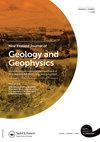用三维地震速度模型重新定位2001-2011年新西兰地震目录,并与南岛南部仪器稀少的2019-2020年自动检测地震进行比较
IF 1.9
4区 地球科学
Q1 GEOLOGY
New Zealand Journal of Geology and Geophysics
Pub Date : 2022-06-30
DOI:10.1080/00288306.2022.2089171
引用次数: 3
摘要
本文章由计算机程序翻译,如有差异,请以英文原文为准。
Catalogue of 2001–2011 New Zealand earthquakes relocated with 3-D seismic velocity model and comparison to 2019–2020 auto-detected earthquakes in the sparsely instrumented southern South Island
ABSTRACT Here we update a catalogue of 2001–2011 New Zealand earthquakes relocated with a 3-D seismic velocity model, which has recent improvements. We use P- and S-wave arrival times from earthquakes during 2001–2011 as these were manually picked with assigned quality. We demonstrate the usefulness of the catalogue by considering results from the southern South Island where GeoNet seismograph spacing is large. Later phase data used automatic picking and processing of arrival times. We relocate the 2019–2020 data from National Geohazards Monitoring Centre (NGMC) and compare seismicity patterns to consider its usefulness. We find that the auto-detected crustal earthquakes are more sparse in most of the southern South Island compared to the earlier analyst-picked data period, including Fiordland, which is one of the most seismically active areas in New Zealand. The auto-detected seismicity pattern is also problematic at greater depth and does not show a seismicity band in the lower crust across Southland evident in 2001–2011 data. The detection capability could be improved with a much denser permanent network. We recommend that the 2001–2011 relocated catalogues be used in studies of tectonics and seismic hazard across the South Island, and in studies that consider New Zealand wide seismicity patterns.
求助全文
通过发布文献求助,成功后即可免费获取论文全文。
去求助
来源期刊
CiteScore
5.10
自引率
27.30%
发文量
34
审稿时长
>12 weeks
期刊介绍:
Aims: New Zealand is well respected for its growing research activity in the geosciences, particularly in circum-Pacific earth science. The New Zealand Journal of Geology and Geophysics plays an important role in disseminating field-based, experimental, and theoretical research to geoscientists with interests both within and beyond the circum-Pacific. Scope of submissions: The New Zealand Journal of Geology and Geophysics publishes original research papers, review papers, short communications and letters. We welcome submissions on all aspects of the earth sciences relevant to New Zealand, the Pacific Rim, and Antarctica. The subject matter includes geology, geophysics, physical geography and pedology.

 求助内容:
求助内容: 应助结果提醒方式:
应助结果提醒方式:


